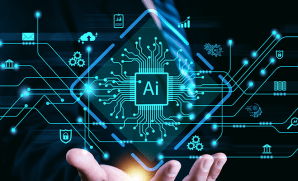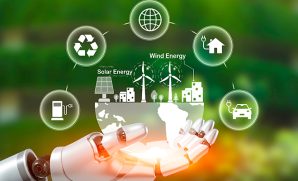Real-world impact and applications driven by Generative AI in 2025
Publish Date: August 28, 2024Hardly any industry is untouched by the Generative AI marketplace today. Incredibly, Gartner’s 2023 Hype Cycle accounts GenAI-enabled applications as one of the key technologies on its path to have a significant impact on organizations over the next ten years. By 2026, over 80% of enterprises will have integrated GenAI into their operations, up from less than 5% in 2023.
This blog, therefore, explores how GenAI is reshaping industries, the challenges ahead, and the exciting future that awaits.
Predictions and real-world applications by 2025
The potential of GenAI by 2025 is immense, with various industries already exploring and implementing innovative applications.

Some vital developments Gartner predicts:
- By 2024: ~40% of business apps will be conversational AI-embedded
- By 2025: ~30% of businesses will deploy AI-enhanced development and testing strategies
- By 2026: ~60% of new apps and sites will be GenAI-designed, while >100 million humans will work with robo-teammates
- By 2027: ~15% of new applications will be GenAI-built automatically without human involvement
These predictions are backed by McKinsey’s analysis, which estimates that GenAI could add up to $4.4 trillion annually to the global economy. GenAI’s adoption, for example, is expected to drive significant advancements in multiple sectors, including automotive, manufacturing, aerospace, and more.
The applications of generative AI do not stop there.
- In healthcare, AI-driven models can be leveraged to analyze medical images with high accuracy, aiding in the early detection of diseases. GenAI-powered chatbots can provide 24/7 support, answer patient queries, and manage appointments, thus reducing the burden on healthcare professionals. By 2025, according to Gartner, GenAI will help discover 30% of new drugs.
- In the financial sector, AI-powered virtual assistants would be capable of handling customer inquiries, processing transactions, and offering investment recommendations, thereby enhancing the overall customer experience.
- In the legal domain, AI models can review and draft documents, perform legal research, and predict case outcomes based on historical data. Given that the lion’s share of routine legal work will be automated by 2025, legal professionals will be able to focus more on complex and strategic work.
This evolution of GenAI will not be without obstacles we must be aware of today.
Challenges in piloting real-world applications
Despite the promising advancements, the journey to fully integrating GenAI into real-world applications is fraught with challenges:
- Today’s GenAI-embedded capabilities still face obstacles like inaccuracy and hallucinations, limiting its widespread adoption. On one side, while this may be due to the technology’s infancy, another could be due to organizations struggling with fragmented data and inconsistent data quality, hindering the AI systems’ performance. GenAI systems, after all, require vast amounts of high-quality data to function effectively.
- To ensure the targeted use cases of GenAI, another challenge we will soon face as per IDC is related to natural trajectory. This is why, despite GenAI investments expected to reach USD 147 billion by 2027, there will be first a constrained rate of spending through 2025.
- There are severe legal and ethical implications of using GenAI, including issues related to bias in AI models, protection of intellectual property rights, and even successfully building a viable proof of concept (POC). As per Gartner, for instance, ~30% of GenAI projects would reach an early grave by the POC stage due to these challenges. Establishing robust frameworks for AI governance will ensure that AI systems are transparent and compliant with regulations.
- The cost of implementing and maintaining GenAI solutions can pose another hurdle. This includes the costs of acquiring the necessary technology, training employees, and ongoing maintenance.

Figure 2: Source – Gartner (July 2024)
Last but not least, integrating GenAI into existing workflows demands that businesses bridge the gap between a fundamental cultural shift and focus on reskilling the workforce to work alongside AI.
In this regard, Microsoft’s initiatives seem to have the right idea.
Microsoft’s pursuit of a Generative AI talent pool
Leading players like Microsoft and OpenAI have been marching in lockstep, where similar to Google’s Palm (a multimodal LLM) and Bard (a pure language model), Microsoft is also exploring infusion of GenAI tech into its products (such as Bing, Office 365, Copilot, Microsoft 365, Google Workplace and more). Of course, ChatGPT’s popularity and Microsoft’s first-mover advantage means that the company wants to be (and probably already is) at the forefront of the GenAI revolution.
Microsoft’s commitment shows not just using GenAI to address pressing business challenges, but also its copious investments and initiatives aimed at democratizing AI skills and applications. For example, the company’s recent ADVANTA(I)GE initiative is going to equip 2 million people in India with AI skills by 2025. CEO and Chairman Satya Nadella also recently announced the landmark step to provide 2.5 million people in ASEAN with similar skills and create an AI-ready talent pool. This is a crucial step toward line up with the ASEAN Digital Masterplan 2025.
As more applications become GenAI-enabled, a broad spectrum of abilities and skill sets will permeate the global workforce.
The inevitable future of Generative AI’s applications
The momentum behind generative AI (GenAI) is undeniable, driven by its capacity to create content, solve complex problems, and enhance productivity. Microsoft, AWS, and Google have already poured hundreds of millions into laying the foundational models on ChatGPT. LLM capabilities are already being built into SAP and Salesforce platforms.
In a world where AGI, or Artificial General Intelligence, holds the potential to match (and even exceed) human intelligence, its applications in global industries will be widespread. Accordingly, new governance and paths for human civilization will present themselves. The following few blogs in this GenAI series will explore the ethical and legal considerations in the use of GenAI as well as how it is revolutionizing the healthcare sector.






